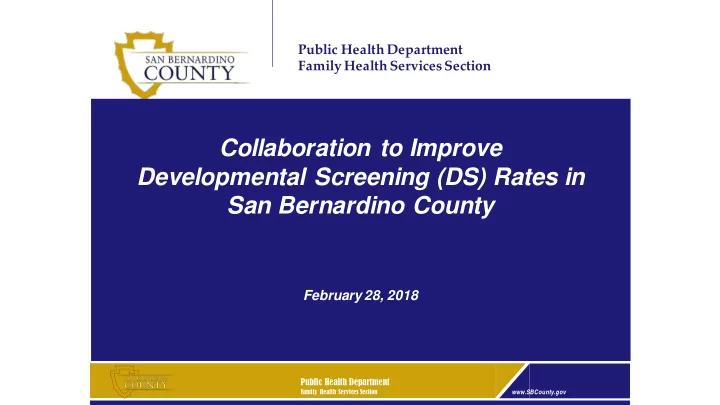

Public Health Department Family Health Services Section Collaboration to Improve Developmental Screening (DS) Rates in San Bernardino County February 28, 2018 Public Health Department Family Health Services Section www.SBCounty.gov
Our Objective By June 30, 2017, at least 40% of CHDP providers serving low income children (uninsured, enrolled in CHDP, Medi-Cal FFS or Managed Care Plans) will implement Developmental Screening according to AAP guidelines.
What Does the American Academy of Pediatrics (AAP) Recommends? Developmental surveillance at every well-child visit and developmental screening using formal, validated tools at 9, 18, and 30 months or whenever a parent or provider concern is expressed. Surveillance and screening activities should be performed within the medical home and coordinated with tracking and intervention services available in the community.
Collaborative Partners – Quarterly Meetings Maternal, Child and Adolescent Health (MCAH) Child Health and Disability Prevention (CHDP) Managed Care Plans (MCP) Inland Regional Center (IRC)
Collaboration with CHDP Identified problem during CHDP recertification visits. Providers phone surveys to establish baseline data, identify barriers and offer support. Survey questions: 1. Screening as required? 2. If so, what screening tools are used? 3. Referrals for those screening positive? 3. If no screening, what are the barriers? 4. How could we help?
Survey Results – Screening Baseline Data [CATEGORY NAME] 145 CHDP Providers 9% YES – 14 NO – 131 YES NO [CATEGORY NAME] 91%
Survey Results Barriers Support Providers stated that: CHDP Nurses provided: Were not aware of AAP Bright Futures Bright Futures, CHDP Health and CHDP requirements. Assessment Guidelines. Confusion about developmental DS Algorithm distributed and surveillance and screening explained requirements. MCP did not require developmental MCP (2) Developmental Screening screening. policies. Did not know where to refer children that California Early Start – IRC referrals screened positive. Screening forms: special discounts Tools are expensive. Reimbursement: FFS and MCP . for California providers. Detailed billing information (FFS).
Collaboration with MCP Problems Solutions Policies and procedures from Providers unaware of MCP both MCP brought to providers requirements. offices. MCP unaware of lack of List of providers that were not compliance. screening plan members was MCP audits did not include shared with MCP. completion of DS. MCAH advocacy - MCP Developmental screening are considering P4P and facilitating not reimbursed separately. screening forms. Cost of screening forms. MCP added DS to audit tool.
Collaboration with IRC Problems Solutions Referral information. Providers did not know IRC simplified referral where to refer. process (phone call by IRC referral form was provider or parent). long and complex. Early Start brochure and Lacking information for Reasons for Concerns for parents handouts made parents. available to providers.
Second Survey End of FY 16/17 Results: YES – 41 [CATEGORY NAME] NO – 101 [PERCENTAGE] YES NO [CATEGORY NAME] [PERCENTAGE]
FY 17/18 Same objective – 40% of CHDP Face-to-face support: sample forms, policies, referrals information, handouts for parents, etc. organized in a binder. Total Technical Support Visits: 83 Yes – 40 = 48% YES YES No – 43 = 52% 48% NO NO 52%
Next Steps Continue participating in the collaborative meetings with CHDP, MCP and IRC. Continue supporting CHDP TS visits (at least 2 a year). Inform MCP of provider compliance. Advocate for MCP to offer training and screening tools to providers. Advocate for MCP provider reimbursement or incentives for completing DS. Inland Empire Health Plan (IEHP) will include reminders in the quarterly Provider’s Newsletter on the expectations of completing developmental screenings. AB 11 (McCarty) – When approved, this bill will put into effect the AAP guidelines by ensuring that developmental screenings, with a validated tool, are routinely occurring for infants and toddlers during Medi-Cal health care visits.
Recommend
More recommend